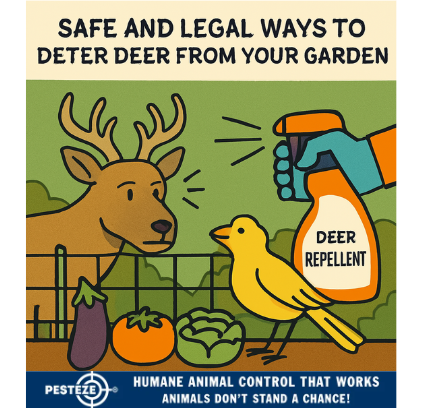SAFE AND LEGAL WAYS TO DETER DEER FROM YOUR GARDEN

SAFE AND LEGAL WAYS TO DETER DEER FROM YOUR GARDEN
SUMMARY
Deer may look graceful, but they can wreak havoc on gardens by eating plants, trampling soil, and damaging landscaping. Deterring deer requires a thoughtful approach that respects wildlife laws and avoids harm. This guide offers safe, legal, and effective strategies to keep deer out of your garden while preserving the beauty and integrity of your outdoor space. Whether you live in a rural area or a suburban neighborhood, these humane methods will help protect your plants and peace of mind.
FEATURES
-
Physical Barriers: Use fencing and netting to block deer access without injury.
-
Scent-Based Repellents: Apply natural or commercial scents that discourage browsing.
-
Motion-Activated Devices: Install sprinklers or lights to startle deer away from your garden.
-
Plant Selection Strategies: Choose deer-resistant plants to reduce attraction.
-
Legal Compliance Tips: Understand local wildlife laws before using deterrents.
-
Seasonal Maintenance: Adjust deterrents and barriers based on seasonal deer behavior.
GUIDE DESCRIPTION
Deer are persistent garden visitors, especially in areas where natural food sources are scarce. While they’re protected in many regions, homeowners still have options to deter them legally and safely. This guide outlines proven methods to keep deer out of your garden without causing harm or violating regulations.
Start with physical barriers. A fence at least 8 feet tall is one of the most effective deterrents. Choose materials like welded wire or mesh netting, and consider angled or double fencing for added protection. For smaller areas, use garden netting or row covers to shield vulnerable plants.
Scent-based repellents can also help. Deer dislike strong odors like garlic, pepper, and predator urine. Commercial repellents are available in spray or granular form and should be reapplied regularly, especially after rain. Homemade solutions using eggs, soap, or vinegar can be effective but may require frequent refreshing.
Motion-activated devices such as sprinklers, lights, or noise emitters can startle deer and discourage repeat visits. These tools are especially useful at night when deer are most active.
Plant selection plays a key role. Incorporate deer-resistant species like lavender, yarrow, and ornamental grasses. Avoid favorites like hostas, tulips, and fruit trees unless well-protected.
Before implementing deterrents, check local wildlife laws. Some areas restrict certain repellents or fencing types, especially near protected habitats. Always choose humane, non-lethal methods.
Finally, adapt your strategy seasonally. Deer behavior changes with breeding and migration cycles, so update your deterrents accordingly. Regular maintenance ensures long-term success.
By combining these safe and legal techniques, you’ll create a garden that’s both beautiful and deer-free—without compromising your values or breaking the law.
- Amy Chang


Comments 0